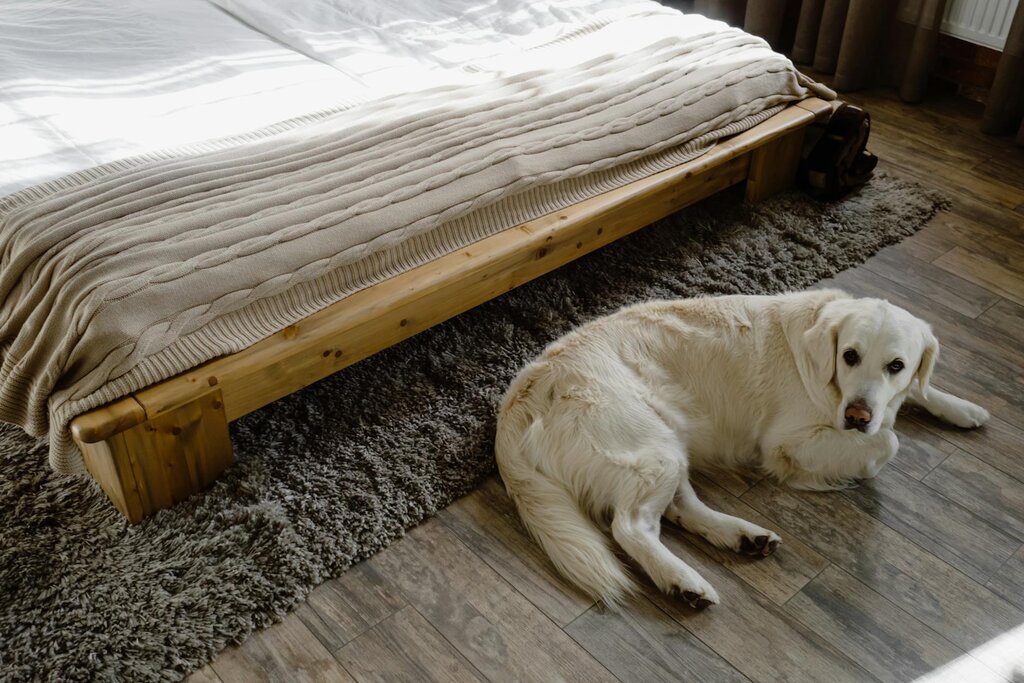Last Updated: 03/06/2025
Arthritis in Dogs
Read this ultimate guide to arthritis in dogs by our vets.
Author: Dr Belinda Stancombe BVSc (Hons)
Reading Time: 25 minutes - medium read
Last Updated: 03/06/2025
Read this ultimate guide to arthritis in dogs by our vets.
Author: Dr Belinda Stancombe BVSc (Hons)
Reading Time: 25 minutes - medium read
Is your dog slowing down? They still enjoy walks but seem to have lost the spring in their step. Maybe they’re struggling to jump onto their favourite chair, or lying down and getting back up has become a challenge.
While it may be easy to blame these changes on aging, there may be more to it. Arthritis is a common condition affecting pets of all ages, often causing pain and limiting mobility.
Don’t let your dog suffer in silence. Learn about arthritis, recognise the signs in dogs, and explore effective treatment options to help support their comfort and improve their quality of life.
Arthritis is a very common condition and while it's hard to watch our pets get older and everything that entails, take some comfort from knowing that there are small actions you can take that can make a big difference to the life of your best friend. If you suspect your dog may be suffering from arthritis or joint pain, it's important to consult your veterinarian for a diagnosis and treatment plan.
Want to read more? Check out our other articles:
Tick, Flea and Worming Guide For Dogs
Our experts continually monitor the health and wellness space and we update our articles when new information becomes available.
Veterinarian
Dr Belinda graduated from The University of Queensland in 2009 and has worked as a Small Animal Veterinarian for over 10 years in South East Queensland. She also has experience as a telehealh consultant, providing veterinary advice for online customers.She has a special interest in animal behaviour, preventative health, the human-animal bond and internal medicine. Outside of work hours she is closely affiliated with a kitten rescue and is also a devoted carer of orphaned rescue kittens.
Your veterinarian will determine the most appropriate pain relief regime for your dog. In some cases, multiple medications may be recommended to achieve the best results. Some forms of pain relief aren't suitable for some dogs due to concurrent health issues, so every case is assessed on an individual basis. Some treatments available include:

Arthritis, scientifically referred to as osteoarthritis or degenerative joint disease, is a degenerative, progressive, and irreversible condition of the joints. While the 'itis' in the word 'arthr-itis' makes us think that it is an inflammatory condition, inflammation is actually only one component of the disease process. While some degree of inflammation does occur, arthritis in dogs is also characterised by a loss of the cartilage (the soft structural component that overlies and protects the bone) and the formation of 'osteophytes' which are new pieces of bone laid down in an effort to protect the joint surface. Low-grade inflammation occurs when destructive enzymes within the joint start to break down the cartilage.
Arthritis can be classified as either primary or secondary. Primary arthritis is due to an intrinsic problem in the cartilage and is associated with ageing - this type of arthritis typically occurs in older dogs as a result of years of wear and tear on the joints. Secondary arthritis occurs due to an external factor or force disrupting the normal cartilage in the joint and most commonly affects a single joint. We typically see secondary arthritis due to physical trauma or injury, such as a cruciate ligament rupture, hip dysplasia and elbow dysplasia. Arthritis in dogs is most often due to a secondary disease.
Dogs are typically stoic animals and many will continue about their day normally even if they are suffering from arthritis. It is not uncommon for pets to continue eating and drinking normally and going for walks even when they are in significant pain meaning owners may be oblivious to the issue. Signs of arthritis can vary depending on the breed of dog and the severity of the illness.
It's important to understand that many dogs won't vocalise when they are in pain, even with significant disease. If you notice any change in your dog's gait or behaviour or you are concerned they may be in pain, always seek veterinary advice. Your veterinarian will perform a physical examination, paying close attention to the joints to assess for swelling, decreased range of motion, pain, instability and lameness.
Vets are taught to look for other important clues such as muscle wastage and stiffness to determine our patient's pain levels. Your vet may recommend further diagnostics such as radiographs, blood work and evaluation of the joint

In all cases of arthritis, there are important steps that you can take which will significantly improve your dog's quality of life. While it's nice to think that a single 'wonder arthritis medication' is effective at controlling pain long-term, in reality multiple techniques may need to be combined in an multimodal approach to be most effective.
Nutrition can support dogs with arthritis in a number of ways. For dogs with arthritis or mobility problems who are also overweight, weight management will be critical to reducing the physical strain on their joints. Weight loss can also help to reduce inflammatory mediators released from fat cells which can also play a role in joint pain and reduced mobility.
Diets for dogs with joint problems are also enriched with nutrients such as green lipped mussel powder and fish oil which help to support healthy cartilage and reduce inflammation in the joints. Both veterinary therapeutic and non veterinary health diet options are available, check with your vet regarding which option they consider most suitable for your dog's needs.
There are a number of natural extracts and herbal products with proven anti-inflammatory properties. Some are antioxidants, which slow the actual progression of arthritis, while others intercept the inflammatory cascade to limit pain and inflammation.
Green lipped mussel contains key omega-3 polyunsaturated fatty acids, glycosaminoglycans (a source of chondroitin), vitamins and minerals which have been shown to have beneficial anti-inflammatory effects in dogs with arthritis. Similar to other joint supplements, it may take several weeks to notice visible effects, however it has been shown to play a role in reducing inflammation and pain in the joints.
Glucosamine and Chondroitin are the building blocks of normal healthy cartilage. Despite a lack of strong evidence in the veterinary literature, some veterinarians and owners have found supplementation to be helpful. With minimal side effects compared to some of the common pain relief medications, they are a good option for mild cases and to use alongside other therapies. See our range of glucosamine supplements for dogs.
Omega 3 fatty acids DHA and EPA have been demonstrated to have anti inflammatory properties, and as far as supplements for arthritis go, they are backed by the most convincing evidence. Omega 3's can be obtained from lots of difference sources including fish oil, green lipped mussel powder, flaxseeds and nuts. Marine sources of omega fatty acids (such as fish, fish oil and green lipped mussel) are the most effective for dogs.
Looking for more information on supplements? Read our article on Your Guide to Pet Supplements.
Keeping dogs with arthritis active is important, but remember balance is key. It is important to not overdo it and lead to discomfort and accelerated cartilage destruction. Low impact exercise options such as swimming or hydrotherapy can be great for dogs that suffer from arthritis. Physiotherapy, acupuncture, massage and therapeutic laser therapy can also help.
There are small changes that you can make at home to improve your dog's comfort and quality of life if they are experiencing joint pain. Ramps, stairs and slings can be used to make stepping up into cars or onto beds easier. Memory foam and orthopaedic beds will also provide additional support for dogs with arthritis, ideally these should be position on carpet or non slip flooring to make getting up a little easier.